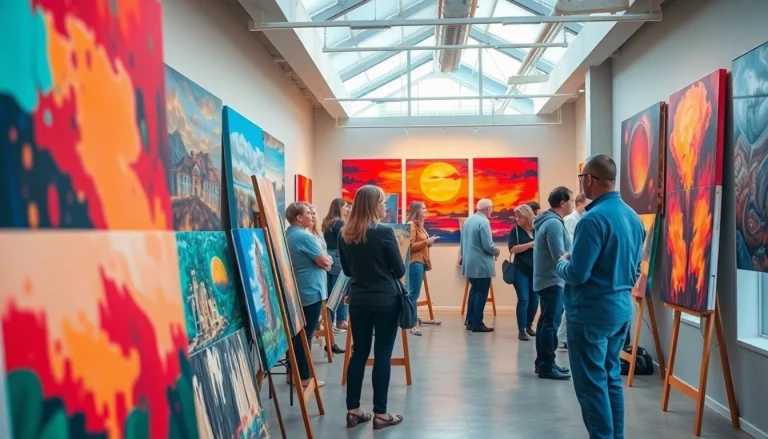Understanding Visual Aesthetics in Art
Visual aesthetics is a cornerstone of artistic expression, shaping how we perceive and interact with art. It encompasses the overall vision a creator wishes to convey, manipulating sensory experiences to evoke thoughts and emotions. For artists and enthusiasts alike, understanding the intricacies of visual aesthetics can transform one’s appreciation and interpretation of art. In the continually evolving landscape of the art world, engaging deeply with Visual Aesthetics becomes essential, whether for creating impactful pieces or curating experiences that resonate with audiences.
The Fundamentals of Visual Aesthetics
At its core, visual aesthetics focuses on the principles of beauty and taste within art. It involves various components that come together to form the visual aspects of any artwork. Typically, these elements include color, form, space, line, texture, and pattern. Each of these factors plays a critical role in shaping the viewer’s experience. For example, strong use of color can evoke emotions, while line can direct attention and create movement within the composition.
Historical Context and Evolution
The study of visual aesthetics is not static; it evolves with cultural shifts and technological advancements. Throughout history, different art movements have attempted to redefine beauty and artistic value—consider the transition from the detailed representations of the Renaissance to the expressive forms of Impressionism and the more abstract interpretations in Modern art. As society has changed, so have the expectations of aesthetics, leading to a greater diversity in styles and approaches to visual interpretation.
Key Elements of Visual Aesthetics
Understanding the key elements of visual aesthetics is crucial for both artists and audiences. The primary components include:
- Color: The emotional weight and symbolism assigned to specific colors can vary dramatically across cultures and contexts.
- Line: Lines can be used to define shapes, direct eyes, and convey movement or stillness.
- Shape and Form: The two-dimensional properties of shape, and the three-dimensional aspects of form, can affect how we perceive an artwork.
- Space: The use of positive and negative space can create balance or tension within an artwork.
- Texture: The tactile quality of materials used in art, which can add depth and interest.
- Pattern: Repeated elements that can create harmony or disrupt visual flows.
Importance of Visual Aesthetics in Art
Visual aesthetics is indispensable to how art is created, conveyed, and received. It bridges the artist’s intention with the audience’s emotional and intellectual responses. Understanding this connection can enhance appreciation and interpretation, leading to a more significant engagement with the art.
Influencing Audience Perception
The way art is presented can significantly affect audience perception. Visual aesthetics shape not only what viewers see but also what they feel. For instance, dark, muted colors can create a somber mood, while bright, saturated colors can energize a space. Artists adopt certain aesthetic choices intentionally to guide viewers’ emotions and evoke specific responses.
Visual Aesthetics and Emotional Response
Emotions play a major role in art appreciation, and visual aesthetics are a key component in evoking those emotions. Research shows that people often respond viscerally to aesthetics before cognitive processes kick in. Thus, artists who skillfully combine elements of aesthetics with emotional depth can provoke meaningful engagement. For example, Van Gogh’s swirling colors and energetic brush strokes in “Starry Night” ignite feelings of wonder and turmoil, compelling viewers to connect with the piece on an emotional level.
Artistic Expression Through Visual Cues
Visual aesthetics allow for the subtle communication of ideas and narratives through imagery. Artists use visual elements as symbols to express concepts, critiques, or viewpoints. A strong understanding of visual aesthetics enables artists to convey messages effectively without relying on text or overt symbolism. This layer of communication widens the accessibility and depth of art beyond immediate interpretation.
Techniques to Enhance Visual Aesthetics
For artists looking to elevate their work, a mastery of specific techniques related to visual aesthetics is crucial. These strategies can sharpen the impact of their artistic expression and deepen viewer engagement.
Color Theory and Its Applications
Color theory is foundational to achieving desired effects in visual aesthetics. It examines how colors interact, the emotional response they elicit, and guidelines for using color harmoniously. Artists can choose complementary colors to create vibrance or monochromatic schemes for a more subdued effect. Understanding warm and cool colors allows for nuanced emotional and spatial transitions within artwork.
Composition Strategies for Artists
Good composition is about organizing visual elements to control the viewer’s experience within the artwork. Techniques such as the rule of thirds, balance, contrast, and leading lines can guide viewers through an piece while maintaining focus on the primary subject. An intentional composition can prevent visual chaos and help in communicating the intended narrative effectively.
Utilizing Light and Shadow Effectively
Light and shadow critically affect visual aesthetics by creating depth and dimension. Artists can manipulate illumination to highlight specific details or moods. Techniques such as chiaroscuro, which contrasts light and dark, can add drama and focus to focal points within a piece. Mastery of how light interacts with various surfaces is key to achieving realism and enhancing physical presence in artworks.
Case Studies: Successful Applications of Visual Aesthetics
Looking at historical and contemporary case studies can provide insights into how visual aesthetics can be effectively harnessed for artistic expression. Following are key examples that highlight unique approaches to aesthetics.
Iconic Artists Known for Their Visual Styles
Artists like Claude Monet, Pablo Picasso, and Frida Kahlo are renowned for their distinctive styles that integrate strong visual aesthetics. Monet’s Impressionistic use of color captures fleeting moments and the essence of light. Picasso’s Cubism shattered traditional perspectives, inviting viewers to see composition and form in entirely new ways. Kahlo’s vivid colors and deeply personal iconography communicate complex emotional experiences uniquely.
Comparative Analysis of Art Movements
From Baroque to Modern art, artistic movements have showcased the evolution of visual aesthetics. The theatrical grandeur of Baroque art contrasts sharply with the minimalist aesthetics of Minimalism. Such analyses not only reveal differing aesthetic values but also show shifting societal norms and cultural contexts that influence art’s direction and appreciation.
Modern Expressions in Digital Arts
The emergence of digital mediums has revolutionized how artists approach aesthetics. Digital art incorporates technology, allowing unique manipulation of visual elements, introducing new aesthetics that blend traditional artistry with graphic design. Artists like Beeple and KAWS exemplify the blend of traditional aesthetics with digital capabilities, pushing the boundaries of visual experiences in contemporary realms.
Measuring the Impact of Visual Aesthetics
The impact of visual aesthetics on art cannot be overstated. Understanding how to evaluate this impact is key for artists and critics alike.
Feedback from Art Viewers and Critics
Art viewers’ feedback is essential in assessing how effectively aesthetics resonate with an audience. Public responses—be it through critiques, gallery reviews, or social media engagement—inform artists about the emotional and intellectual connections made through their work. Constructive criticism from experts can offer nuanced insights into the aesthetic experience beyond the artist’s intention.
Metrics for Evaluating Aesthetic Success
Beyond subjective feedback, tangible metrics, such as visitor numbers to exhibitions, social media engagement rates, and sales, provide measurable indicators of a work’s impact. Artists should be attentive to these metrics, employing them to refine both style and aesthetic philosophy as they evolve.
The Future of Visual Aesthetics in Art
The future of visual aesthetics is likely to be influenced by continued technological advancements and evolving cultural landscapes. As virtual and augmented realities expand the way people experience and interact with art, the concepts of aesthetics will broaden, demanding innovative approaches to visual communication. Artists who can integrate these elements creatively will undoubtedly shape the future of artistic expression in unprecedented ways.























+ There are no comments
Add yours